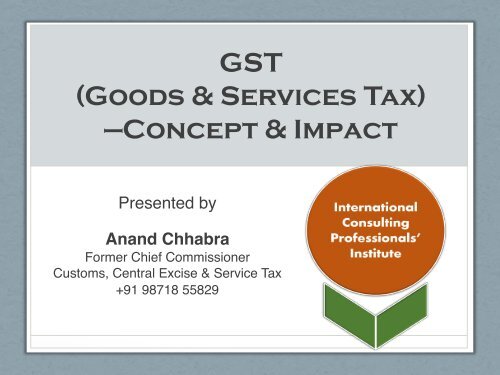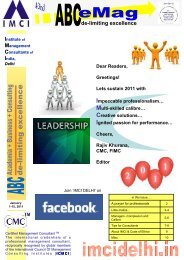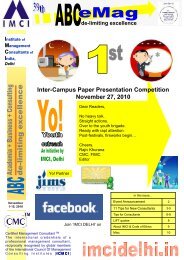You also want an ePaper? Increase the reach of your titles
YUMPU automatically turns print PDFs into web optimized ePapers that Google loves.
<strong>GST</strong><br />
(Goods & Services Tax)<br />
—Concept & Impact<br />
Presented by<br />
Anand Chhabra<br />
Former Chief Commissioner<br />
Customs, Central Excise & Service Tax<br />
+91 98718 55829
In Praise of <strong>GST</strong><br />
The Goods & Services Tax is here.<br />
Most other taxes will disappear.<br />
One massive overhaul.<br />
One tax to rule them all,<br />
Till the slabs and<br />
Exemptions appear.
Indirect Taxation<br />
—The Present<br />
v Inefficient and distortionary Cascading (burden of "tax on tax”):<br />
Lowers productivity, resources are misallocated, hampers<br />
economic growth<br />
v Inhibits voluntary compliance as taxation regimens confusing to the<br />
tax payer & to the tax collector<br />
v Plethora of tax laws; rates; agencies; processes in different States<br />
v Chaotic, for lack of synchronization in the taxation regimens of<br />
Centre & the States<br />
v Huge wastage of time & effort involved in tax collection<br />
v Limited number of taxpayers, so the honest ones are at a<br />
disadvantage; huge tax evasion
<strong>GST</strong> Features 1<br />
v A destination-based tax on consumption of goods & services. To be<br />
levied at all stages right from manufacture up to final retail sale (before<br />
consumption) with credit of taxes paid at previous stage available as<br />
setoff. In sum, only value addition is taxed & the burden of tax is entirely<br />
borne by the final consumer<br />
v The tax to accrue to the taxing authority having jurisdiction over the<br />
place of consumption or place of supply. ‘Supply’ includes sale, transfer,<br />
barter, exchange, licence, rental, disposal for a consideration<br />
v Replaces origin-based multiple taxes on manufacture, distribution, sale,<br />
services; dual taxation ‘goods’ & ‘services’; MRP based valuation<br />
v A robust, uniform & comprehensive tax, removes differentiation as<br />
goods & services move through the supply chain<br />
v Standard slabs: 0% (0-2), 5% (3-8) 7%, 12% (9-14) 28%, 18% (15-20)<br />
31%; 28% (21 & above) 25% (% of tax base)<br />
v One country, One tax
<strong>GST</strong> Features 2<br />
v Proposes to subsume the following indirect taxes levied by the<br />
Centre on goods & services:<br />
Central Excise; Duties of Excise (Medicinal and Toilet<br />
Preparations); Additional Duties of Excise (Goods of Special<br />
Importance); Additional Duties of Excise (Textiles and Textile<br />
Products; Additional Duties of Customs (commonly known as<br />
CVD); Special Additional Duty of Customs (SAD); Service Tax;<br />
Central Surcharges and Cesses<br />
v Proposed to subsume the following indirect taxes levied by the<br />
States on goods & services:<br />
State VAT; Central Sales Tax; Purchase Tax; Luxury Tax; Entry Tax<br />
(all forms); Entertainment and Amusement Tax (except those levied<br />
by the local bodies); Taxes on advertisements; Taxes on lotteries,<br />
betting and gambling; State Cesses & Surcharges
<strong>GST</strong> Features 3—ITC<br />
v Full Input Tax Credit (ITC) on capital goods on one go<br />
v Proportionate credits allowed in case inputs, inputs services &<br />
capital goods are partly used for business & partly for non-business<br />
purposes<br />
v Proportionate credits allowed in case inputs, inputs services and<br />
capital goods are used for taxable including zero rated and exempt<br />
(including non-taxable) supplies<br />
v ITC cannot be availed after filing of return for the month of<br />
September of next Financial Year or filing of Annual Return<br />
v ITC available only on provisional basis for a period of two months<br />
until payment of tax and filing of valid return by the supplier<br />
v Matching of supplier’s and recipient’s invoice details<br />
ü ITC to be confirmed only after matching of such information<br />
ü ITC to be reversed in case of mis-match<br />
v Input Service Distributor mechanism for distribution of ITC of input<br />
services
<strong>GST</strong> Features 4—I<strong>GST</strong><br />
v The Centre to collect I<strong>GST</strong> (=C<strong>GST</strong>+S<strong>GST</strong>) on all inter-State<br />
supplies<br />
v The inter-State supplier would adjust credit of I<strong>GST</strong>, C<strong>GST</strong> and<br />
S<strong>GST</strong> on his purchases (in that order)<br />
v The exporting State will transfer to the Centre the credit of S<strong>GST</strong><br />
used in payment of I<strong>GST</strong><br />
v The importing dealer will claim credit of I<strong>GST</strong> while discharging his<br />
output tax liability (both C<strong>GST</strong> and S<strong>GST</strong>)<br />
v The Centre will transfer to the importing State the credit of S<strong>GST</strong><br />
used in payment of I<strong>GST</strong><br />
v Since <strong>GST</strong> is a destination-based tax, all S<strong>GST</strong> on the final product<br />
will ordinarily accrue to the consuming State in seamless flow of<br />
input tax credit from one State to another
<strong>GST</strong> Features 5<br />
v Dual <strong>GST</strong> (simultaneous)—C<strong>GST</strong> & S<strong>GST</strong>—to maintain uniformity<br />
in the fiscal federal structure:<br />
ü On every transaction<br />
ü On common tax base<br />
ü At the same price or value<br />
ü On same classification for goods—Harmonised System<br />
Nomenclature (use of nil, 2-digit, 4-digit codes relate to turnover)<br />
ü On same classification of services—Services Accounting Code<br />
v The Centre would levy and administer on all supplies (goods &<br />
service):<br />
ü C<strong>GST</strong> (Central <strong>GST</strong>) on Intra-State supplies<br />
ü I<strong>GST</strong> (Integrated <strong>GST</strong>) on Inter-state supplies<br />
v S<strong>GST</strong> (State <strong>GST</strong>) would be levied and administered by the States<br />
on all Intra-state supplies
<strong>GST</strong> Features 6<br />
v No cross utilization of credit would be permitted between the<br />
Centre & the States<br />
ü The input tax credit (ITC) of C<strong>GST</strong> available for discharging the<br />
C<strong>GST</strong> on the output at each stage<br />
ü ITC of S<strong>GST</strong> allowed for paying the S<strong>GST</strong> on the output<br />
v Cross utilization of credits of C<strong>GST</strong> & S<strong>GST</strong> is permissible but<br />
under I<strong>GST</strong> model<br />
v <strong>GST</strong> payments to be deposited with respective agency<br />
v The list of exempted goods and services would be kept to a<br />
minimum<br />
v <strong>GST</strong> would be harmonized among the Centre & the States
<strong>GST</strong> Features 7<br />
IMPORTS<br />
v Import of goods and services will be treated as inter-state supplies<br />
and I<strong>GST</strong> levied<br />
v Incidence of tax will follow the destination principle and the tax<br />
revenue will accrue to the State where the goods & services are<br />
consumed<br />
v Full & complete set off will be available on <strong>GST</strong> paid on import<br />
EXPORTS<br />
v Export will be treated as Zero-rated supplies & hence no tax<br />
v However, credit of ITC available and granted as refunds to the<br />
exporters
<strong>GST</strong> Example<br />
Without <strong>GST</strong><br />
With <strong>GST</strong><br />
Sale from Mumbai to Nagpur<br />
Price Rs. 1000<br />
VAT (10%) – Rs. 100<br />
Sub Total: Rs. 1100<br />
Further sale from Nagpur to Chennai<br />
Profile – Rs. 1000<br />
Selling Price – Rs. 2100<br />
CST (10%) – Rs. 210<br />
Total Cost: Rs. 2100+210=2310<br />
Sale from Mumbai to Nagpur<br />
Price Rs. 1000<br />
C<strong>GST</strong> (5%) – Rs. 50<br />
S<strong>GST</strong> (5%) – Rs. 50<br />
Sub Total: Rs. 1100<br />
Further sale from Nagpur to Chennai<br />
Profit – Rs. 1000<br />
Selling Price – Rs. 2100<br />
I<strong>GST</strong> (10%) – Rs. 210<br />
Tax Payable – Rs. 210-(50+50)=Rs.110<br />
Total Cost: Rs. 2100+110=2210
<strong>GST</strong> Features--<br />
Exceptions<br />
v <strong>GST</strong> would apply to all goods & services except Alcohol for human<br />
consumption<br />
v <strong>GST</strong> on five Petroleum Products viz. Crude, Petrol, Diesel, ATF &<br />
Natural Gas would be applicable from date to be announce later<br />
v Tobacco and Tobacco products would be covered by <strong>GST</strong> but the<br />
Centre would continue to levy Central Excise duty on them<br />
v Tax payers will annual turnover below Rs. 20 lakh (Rs. 10 lakh for<br />
North Eastern States) would be exempt from <strong>GST</strong><br />
v Optional compounded levy at flat rate would be available for<br />
turnover up to Rs. 50 lakh. However, both these are optional<br />
v Statutory services rendered by Govts., Local, Panchyat authorities<br />
rendered to citizens (section 9 read with Schedule IV)<br />
v The States still may opt for continuance of Stamp Duty, Vehicle Tax
<strong>GST</strong> Governance<br />
v The <strong>GST</strong> policy will be governed by the <strong>GST</strong> Council, under the<br />
Union Finance Minister, to make recommendations to the Union<br />
and the States on parameters like rates; exemption list; threshold<br />
limits; model <strong>GST</strong> Laws; principles of levy, place of supply;<br />
apportionment of I<strong>GST</strong>; modalities for dispute resolution with the<br />
taxpayer; mechanism to resolve cases of dispute in between Centre<br />
and State(s) or between one or more States<br />
v Administration:<br />
ü C<strong>GST</strong> & I<strong>GST</strong>, to be administered by CBEC, Ministry of Finance<br />
ü S<strong>GST</strong> to be administered by the respective State Commercial<br />
Tax Depts.<br />
ü The Centre & the States would have concurrent jurisdiction for<br />
the entire value chain
<strong>GST</strong>N (<strong>GST</strong> Network)<br />
v <strong>GST</strong>N, a not-for-profit, non-Govt. company, set up to implement the<br />
<strong>GST</strong>, with Central & State Govts. as partners. To provide shared IT<br />
infrastructure & services to tax-payers and other stakeholders<br />
v Common online portal provides three core front-end services:<br />
Registration, Returns and Payments<br />
v And backend (online): identifying mismatched returns, assessment,<br />
audits, appeals, links to banks & RBI<br />
v <strong>GST</strong>N aims to go for:<br />
ü Simplicity for taxpayers<br />
ü Autonomy for the States<br />
ü Uniformity of policy administration<br />
ü Digitization and automation of whole chain<br />
ü Leakage reduction<br />
ü Leveraging existing investments
Benefits for Business<br />
and Industry 1<br />
v Common tax rates; simpler tax regimen—fewer rates, exemptions;<br />
subsuming of multiple taxes; efficient neutralization of taxes<br />
particularly for exports; cascading mitigation; a common PANbased<br />
taxpayer ID; a common return & challan for tax payment;<br />
quick refunds; a comprehensive & robust IT system; seamless taxcredits<br />
throughout the value-chain and across boundaries of<br />
States; stable, predictable, transparent laws & processes would:<br />
ü Foster a common market across the country (Uniform Prices)<br />
ü Create certainty & ease of doing investment/ business anywhere<br />
ü Self monitoring regimen & taxpayer friendly processes for<br />
migration, returns, refunds<br />
ü Reduce hidden, transaction & logistics costs (including time);<br />
lead to lower prices of goods & services
Benefits for Business<br />
and Industry 2<br />
ü Reduction in overall tax burden on goods<br />
ü Reduction in cost of manufactured goods & services improves<br />
competitiveness in the international market & hence promotes<br />
exports<br />
ü Spur economic growth (Increased GDP)<br />
ü Incentivize tax compliance by traders<br />
ü Huge dispute reduction<br />
ü Amenable to both ‘B2B’ as well as ‘B2C’ transactions (tax<br />
payable as Tax Collected at Source (TCS)<br />
ü Broadening of tax payer base, increase in trade volumes and<br />
improved tax compliance will lead directly to reduction of tax<br />
rate; uniformity in tax rates & taxation policies among the States
Benefits for Central &<br />
State Governments<br />
v Replacement of multiple taxes at the Central and State; fewer<br />
taxes & exemptions; seamless transfer of input tax credit from one<br />
stage to another; reduction in forms; backed with a robust end-toend<br />
IT system, <strong>GST</strong> would:<br />
ü Be simpler and easier to administer<br />
ü Reduce leakages drastically<br />
ü Decrease the cost of collection<br />
ü Higher revenue collection efficiency<br />
ü Improved forecasts in collections & hence improved budgeting<br />
ü Optimize efficiency, equity and effectiveness among the States<br />
and the Centre and thus strengthen the federal structure<br />
ü A unified common national market to boost FDI & Make in India
Benefits for the<br />
Consumer 1<br />
v Simpler tax system<br />
v Uniform prices throughout the country<br />
v Replacement of multiple Central and State Govt. taxes; removal of<br />
tax exemptions and input tax credits at each stage would:<br />
ü Provide transparent tax regimen<br />
ü Give relief in overall tax burden<br />
ü Reduce retails prices of most commodities & services on longterm<br />
v Increment in employment opportunities<br />
v Higher collections may lead to lower corporate and personal<br />
income taxes, which will encourage more foreign direct investment<br />
and finally to overall economic growth
Challenges<br />
v Rolling out <strong>GST</strong> a huge challenge involves:<br />
Huge volume of dynamic online transactions; security of<br />
transactions—making it hacker proof against frauds, cyber crime,<br />
sabotage; establishing administrative structure & expertise in the<br />
States; freezing processes; training; administrative work involved in<br />
compliances<br />
v Educating the tax-payers (manufacturers, traders, transporters,<br />
consumer) for the change<br />
v Training the Service Providers in the market place, such as CAs;<br />
Accountants; Company Secretaries; Legal Counsels so as to<br />
empower them to facilitate compliances<br />
v May initially increase selling prices (but it would be temporary, till<br />
the processes are in place)
Future<br />
v Transparent & uniform taxation regimen—politically insulated<br />
v Broaden tax base—that will lead to huge buoyancy in revenues<br />
v Huge reduction in tax burden over time—revival of industry/markets<br />
v Will eventually lead to single and lower tax regimen<br />
v Digitisation & e-payment revolution<br />
v Drastically reduce inefficiencies in logistics sector<br />
v Demand for PC, laptops, iPads goes up along with demand for<br />
skilled manpower<br />
v Huge opportunity for trainers/ entrepreneurs<br />
v Simple to implement processes & standardisation will boost<br />
confidence of the industry, the taxpayer & foreign investor in the<br />
Governments and will strengthen ‘Make in India’ & ‘One Nation<br />
One Tax’ projects
<strong>GST</strong>—At A Glance
















